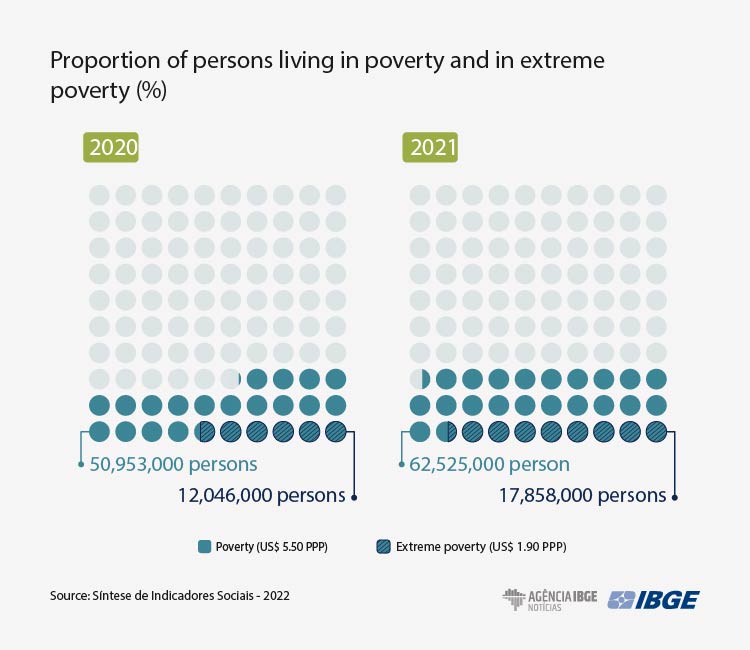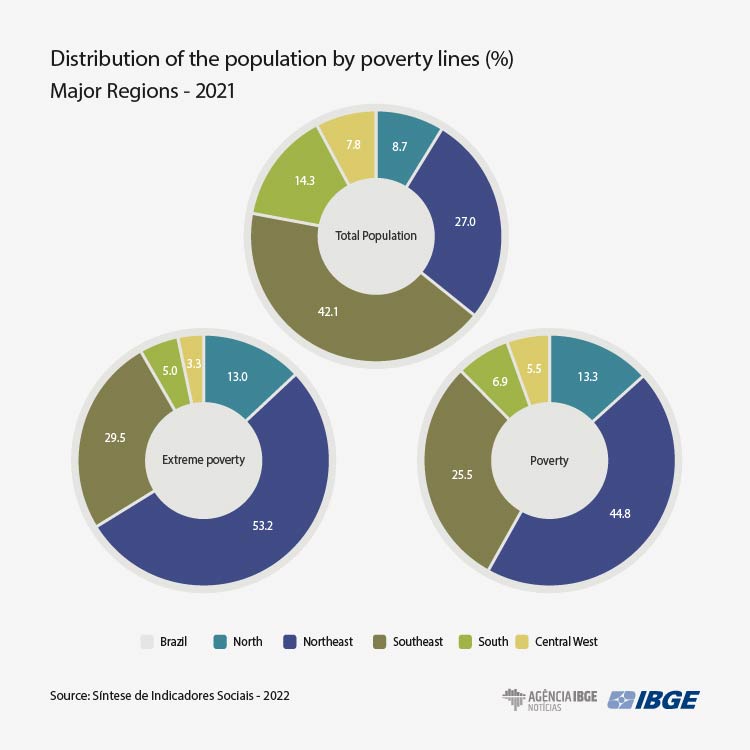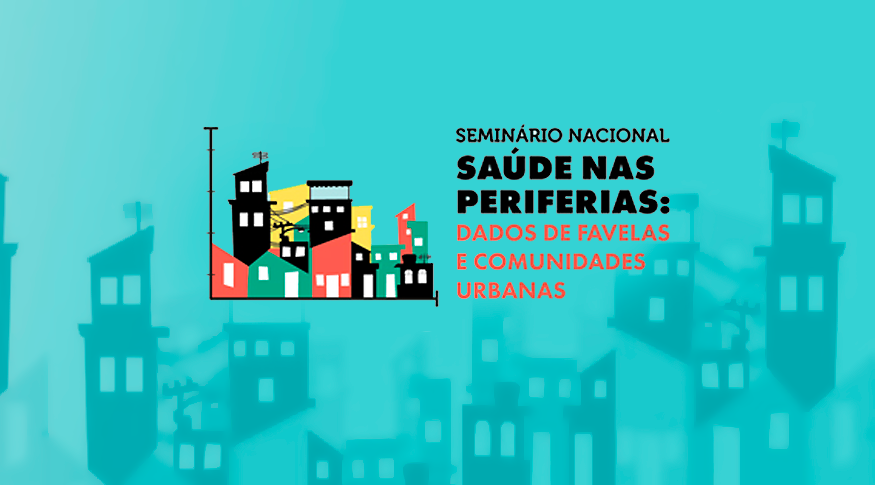Summary of Social Indicators
Poverty hits a record in 2021, 62.5 million persons, highest level since 2012
December 02, 2022 10h00 AM | Last Updated: December 05, 2022 06h07 PM
Highlights
- In 2021, according to criteria of the World Bank, 62.5 million persons (29.4% of the population in Brazil) were in living poverty and, among those, 17.9 million were in extreme poverty (8.4% of the population).
- In 2021, the proportion of children under 14 years of age below the poverty line reached 46.2%, lowest percentage in the series, initiated in 2012.
- The proportion of black and brown persons below the poverty line (37.7%) is almost twice as the proportion of white persons (18.6%).
- The Northeast (48.7%) and North (44.9%) had the biggest proportions of poor people in their populations.
- In 2021, the per capita household earnings fell to R$1,353, lowest level since 2012.
- The Gini indez increased again and reached 0.544, second highest level in the series.

In 2021, considering poverty lines set by the World Bank, about 62.5 million persons (or 29.4% of Brazil population in the country) were living in poverty. Among those, 17.9 million (or 8.4% of the population) were living in extreme poverty. Those were the main figures and highest percentages in both groups, since the beginning of the series, in 2012.
Also, between 2020 and 2021, there was a record incease in these two groups: the number of persons below poverty live increased 22.7% (by more than 11.6 million persons) and that of persons living in extreme poverty did by 48.2% (5.8 million).
The World Bank adopts as poverty line a per capita income of US$ 5,50 PPP, which is equivalent to R$ 486 per month per capita. The extreme povert line is US$ 1.90 PPP, or R$ 168 per month per capita.

In 2021, the proportion of children under 14 years of age below the poverty line reached 46.2%, highest percentage in the series that started in 2012. This proportion had fallen to its lowest level (38.6%) in 2020, but had a record increase.
The proportion of black and brown persons below poverty line (37.7%) is almost twice as the proportion of white persons (18.6%). The percentage of poor youth aged 15 to 29 (33.2%) is three times that of the elderly (10.4%). Still in 2021, about 62.8% of the persons who live in households headed by a woman and with with children under 14 year of age were below poverty line.
In the regional analysis, the Northeast (48.7%) and North (44.9%) had the biggest proportions of poor persons in their population. In the Southeast and also in the Central West, 20.6% (one out of every five residents) were below poverty line. The lowest percentage was registered in the South region: 14.2%.

Earnings had smallest participation in the total income of the poorest
Earnings accounted for 75.3% of the total population income, whereas Benefits from social programs made up 2.6%. But among persons earning up to 1/4 of a minimum wage per capita, earnings represented 53.8%, whereas the share from social programs reached 34.7%. “Those are more vulnerable housing units with limited access to the labor market. Therefore, social programs ende up having a bigger impact,” says André Simões, analyst of the survey.
In 2021, per capita average household earnings reached the lowest level in the time series initiated 2012: R$1.353 “A recuperação do mercado de trabalho em 2021 não foi suficiente para reverter as perdas de 2020. This factor, and the reeuction in the Emergency Aid value, may account for the result,” Mr. Simões explains.
Income decreases mostly among women, black and brown persons and in the North and Northeast
Considering per capita average income per capita of men (R$1,393), they earned 5.9% more than women (R$1.315). In the comparison with 2020, decrease in income amounted to 6.9%, being highest among women (7.5%) than among men (6.4%). Considering the start of the time series, the average annual decrease was 4.5%, but women (-5.9%) faced a bigger decrease than men (-3.0%).
Throughout the series, black and brown women remained earning half of that of white persons and that was not different in 2021: R$949 versus R$1,866, respectively. Both earnings fell from 2020, but losses were more pronounced among black and brown persons (8.6%) in comparison with white ones (6%).
Per capita earnings fell in all the Major Regions, between 2020 and 2021, but with bigger intensity in the Northeast (-12,5%) and North (-9.8%).
Household income records bigger decrease among the poorest
Against 2020, all the income strata recorded decreases in per capita average household in 2021, with the first two strata as the main highlights. That is, the stratum that encompasses up to 10% of the persons earning less in the population recorded the biiggest decreases (-32.2%). The following stratum followed, with 19.8%. “In overall terms, it is possible to say these two strata with the poorest population recorded the biggest decrease in earnings, having lost about 1/ to 1/5 of the income in 2021,” Mr. Simões explains. The main decrease was observed among the stratum with highest earnings, which fell by 4.5% from one year to the next.
In the comparison 2019-2021, the first stratum lost more than twice (22.1%) as the total average (10.9%). In the series (2012-2021), this population had a cumulative decrease of 31.3%, extremely above average, which lost 4.5% in the period.
Inequality index rises again and reaches second highest level in the series
In 2021, the Gini Index rose and hit the same level as in 2019, the second highest in the series, 0.544 - the number one figure was 0.545, in 2018. As for the start of the series, in 2012, this rate fell up to 2015 and increased up to 2018. Given the effects of the distribution of emergency income transfers due to the Covid 19 pandemic, the index had fallen in 2020.
In regional terms, the Northeast had the highest Gini index (0.556) and the South region, the lowest (0.462). Among the state, the index was 0.424 in Santa Catarina whereas Roraima reached 0.596, a difference of 40.6%.




















